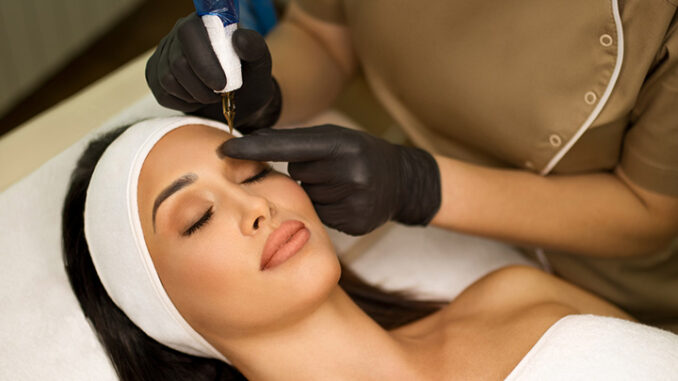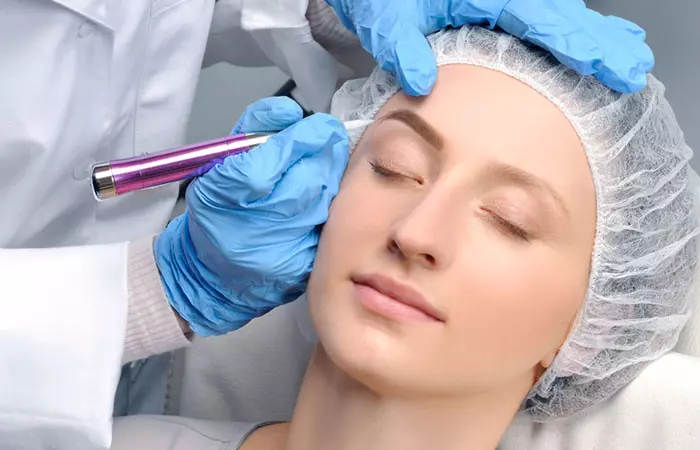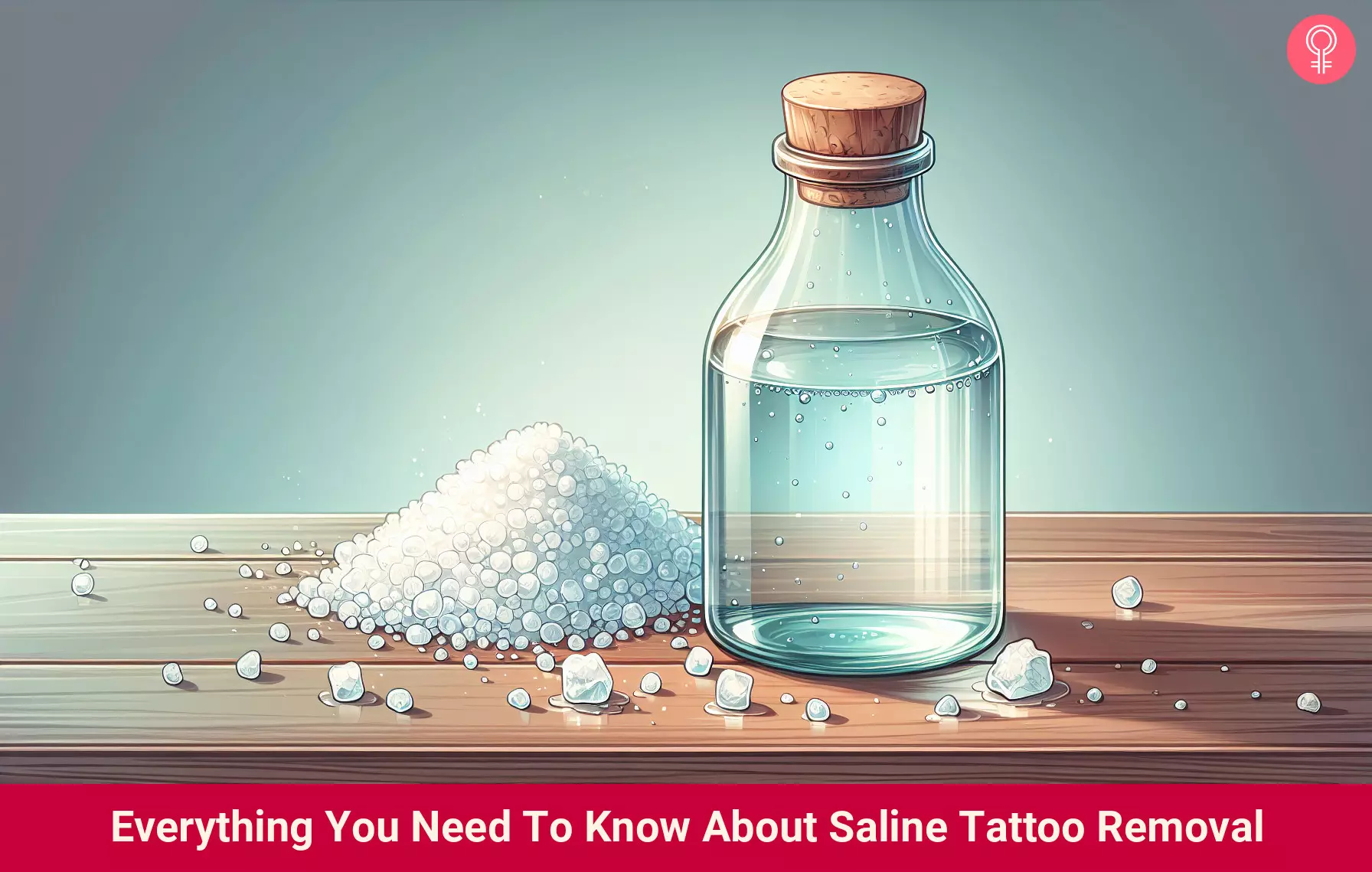
As exciting and wonderful as getting a tattoo feels, getting it removed may seem like such a pain! But nowadays, there are effective ways to get rid of an unwanted tattoo, and the saline tattoo removal procedure is one of the most popular methods. If you have a small or permanent makeup tattoo that you have outgrown or no longer want on your skin, you can happily consider saline tattoo removal. This method has become the favorite of most tattoo artists and their clients for many reasons. It is quick, affordable, and arguably a safer option for your skin. If you have decided to fade away that unwanted tattoo, this article has all the information you need to know about saline tattoo removal. Scroll down to learn more!
What Is Saline Tattoo Removal?
 Image: Shutterstock
Image: Shutterstock
Saline tattoo removal is a method of fading or removing tattoos from the skin by injecting medical-grade salt and purified water. It is suitable for all skin types and has become quite popular in recent years for its ease. Saline tattoo removal is very similar to the tattooing process, but instead of depositing the ink into the skin, the tattoo pigments are pulled out from it. In this process, the artist injects a saline solution into the tattooed area. The solution will eventually draw out or push out the ink deposited into the skin through the osmosis effect.
This process is effective and suitable for people who want to remove small tattoos or permanent tattoo makeup, such as brow hair reshaping or other cosmetic tattoo designs. This method is different from traditional tattoo removal procedures like laser treatment as it does not break down the ink.
Scroll down to get an in-depth idea of how exactly this saline tattoo removal procedure works.
How Does Saline Tattoo Removal Work?
The saline tattoo removal process involves using natural ingredients, such as pharmaceutical salt and sterile water, to fade the ink particles. During a saline tattoo removal session, the technician uses a machine similar to a tattoo machine to inject the solution into the skin. The needles in the machine puncture the skin to insert the solution into the tissues containing the ink.
The solution triggers a trauma response, and as the healing occurs, it carries away some of the ink through the osmosis process during skin regeneration. The method works along with the body’s natural process to fade the color pigments.
A saline removal procedure may require multiple sessions to achieve the desired effect. The success of the treatment depends on factors like the size and color of the tattoo and individual skin characteristics.
Now you know that it works differently than the laser removal method, learn the significant differences between the two processes in the next section.
Saline Tattoo Removal Vs. Laser Tattoo Removal
Both saline tattoo removal and laser treatment are popular methods for erasing tattoos. If you are contemplating which one to choose, we can explain the differences to help you choose. While laser tattoo removal is extremely effective, it is more costly than saline tattoo removal. Here are other important differences between saline and laser tattoo removal that you must consider before selecting one:
1. Process
During a laser removal procedure, the ink particles are broken down by a laser beam at high wavelengths. In a saline removal process, the tattoo ink gets pulled out from the skin by a saline solution injected into the tattooed area. In both methods, the tattoo begins to fade as the skin heals and regenerates. You may require multiple sessions for both procedures to remove the tattoo.
2. Ink Quality
Most artists prefer to use organic inks certified for tattooing. However, some tattoo inks, especially blue and red inks, may contain heavy metals and other harmful substances. While the saline solution may help reduce the pigmentation of these inks, laser treatment may cause more health risks and complications if done on such inks.
3. Color Of The Tattoo
 Image: Shutterstock
Image: Shutterstock
Laser technology requires specific wavelengths of light to work effectively. If the colors of your tattoo do not absorb the laser rays effectively, it can be tough to erase those tattoos. Usually, lasers cannot detect lighter colors, such as yellow, white, and pale green shades, easily. However, the saline method works effectively for all colors.
4. Cost Of Treatment
Cost is another significant differentiator. Laser treatment is considerably expensive and may not fit everyone’s budget. Certain inks may require specialized laser beams that could increase the cost of a laser treatment even more. Saline removal is an alternative to laser tattoo removal that would be more suitable for people who do not want to spend a fortune.
5. Pain Level
Saline treatment involves injections, so it’s almost as painful as getting a tattoo would feel. On the other hand, laser treatment also causes discomfort, and the technician may use anesthetics or cooling treatment to soothe the skin.
6. Rate Of Recovery
In case of a laser treatment, the area remains tender for the first few days and recovers in a few weeks after scabbing. During a saline tattoo removal, you may experience redness and swelling initially, and recovery may take 2-4 weeks, depending on the size and depth of the tattoo.
7. Number Of Sessions
It may take 3-7 laser sessions to remove a tattoo, depending on the size, depth, color, and age of the tattoo. Similarly, saline tattoo removal may require 2-6 sessions.
8. Effectiveness
Laser removal done by professionals is highly effective and can be used for the complete removal of the tattoo. Whereas saline tattoo removal works for fading or partial removal of the tattoo.
If you want to fade small tattoos with lighter colors and semi-permanent makeup, saline tattoo removal is better than laser tattoo removal. Apart from that, saline tattoo removal is also a safe bet for specific cases. Let’s learn more about it in the next section.
What Is Saline Tattoo Removal Best Used For?
Various tattoo removal processes have different applications. Each procedure has its perks and demerits and is best suited for certain cases. Here are some cases where saline tattoo removal works the best:
1. Partial Fading Traditional Tattoo Designs
If you do not want to remove your tattoo but fade some parts of it and make some edits to the design, saline tattoo removal is your best bet. It can help you cover the tattoo partially, add new elements, change colors, modify text, or resize it.
2. Microblading Fading
 Image: Shutterstock
Image: Shutterstock
Microblading involves creating fine strokes, similar to the natural brow hair, by hand to add semi-permanent pigments to the eyebrows. These tiny lines are difficult to catch with a laser, making saline removal a viable option.
3. Eyebrow Tattoo Removal
Thick brows were quite on trend for some time. However, if you no longer adore your brow tattoos, saline tattoo removal might be the best option for fading or lightening your brow tattoo and revealing your original, thinner eyebrows.
These were a few instances where the saline removal technique works best. But can you try this procedure at home? Find out in the next section.
Can I Perform Saline Tattoo Removal At Home?
 Image: Shutterstock
Image: Shutterstock
The simple answer to that question is – No! It is extremely dangerous and may cause serious skin damage if anything goes wrong while removing your tattoo. So, it goes without saying that you cannot allow just anyone to remove your tattoo. Conduct your research and consider a professional and experienced tattoo artist to get a saline tattoo removal treatment.
Although you cannot perform saline tattoo removal at home, you can follow a few precautionary tips before the procedure and support the healing process after getting a tattoo removed. Scroll down to the next section to learn more.
Saline Tattoo Removal: Pre- And Post-Treatment Care Tips
Before taking the saline treatment for tattoo removal, it is crucial to confirm the suitability of this procedure for your body type. Talk to your technician clearly about your tattoo and any underlying issues or allergies you might have. Here are a few things to consider before going ahead with the treatment:
You must be an adult with no major skin issues. You must not be pregnant or breastfeeding. Your body must be capable of healing wounds.
Here are a few steps to follow during the aftercare process for fast and hassle-free recovery:
Allow the wound to dry and heal without disturbing it. You may cover the wound with a dermatologist-recommended bandage or protective film to avoid the risk of infection. Do not peel off the scab. Otherwise, it may delay healing and increase the risk of infection. Let the scabs fall off on their own. During the initial stage after the treatment, you may experience lymph fluid drainage. Blot it with a clean paper towel gently without rubbing the skin. Do not apply cosmetics or makeup on the area, as it may cause infection and delay or hinder the healing process. Limit the exposure to water, as letting the wound dry is elemental to the healing process. Use a vitamin E oil or serum recommended by your technician to keep the area hydrated once the scabs fall off.
While the saline method may seem appealing, individuals considering tattoo removal should be aware of the potential risks and side effects associated with this technique. Move to the next section to learn about its risks and side effects.
Risks And Side Effects Of Saline Tattoo Removal
The saline method is getting increasingly popular due to its convenience and safety. However, there are still risks and side effects involved with this non-laser tattoo removal method.
Risks
1. Infection
This tattoo removal method creates an open wound that is vulnerable to infections. This risk increases if the procedure is carried out in a non-sterile environment and proper aftercare is not followed.
2. Scarring
 Image: Shutterstock
Image: Shutterstock
The saline tattoo removal procedure may potentially cause skin damage and permanent scarring. This may happen when the treated area is large and one hasn’t undergone the required number of sessions.
3. Skin Pigmentation Issues
The saline solution may affect melanin production, cause changes in skin pigmentation, and lead to hyperpigmentation or hypopigmentation.
Side Effects
1. Redness
The saline solution may cause redness and itching. While it usually subsides within a few hours, some may experience excessive redness and swelling, which may indicate an infection.
Wendy, a YouTuber, shares her experience of removing her microbladed eyebrows through the saline tattoo removal process in her video. However, one drawback she noticed was that her skin turned red. She says, “And then she (the tattoo technician) goes, ‘Wendy, this is going to feel like liquid fire on your face.’ and it did. She put it on there and I just closed my eyes and tried to meditate for five minutes but I am telling you it hurt… I was red and raw (i).”
2. Scabbing
During the healing process, the wound causes scabbing and sometimes even blistering.
3. Pain
 Image: Shutterstock
Image: Shutterstock
People may experience swelling, irritation, and pain when the solution is injected into the skin. However, most technicians apply a numbing cream before and throughout the process to help minimize the pain and discomfort.
The saline tattoo removal method is emerging as one of the top choices of tattoo professionals and their clients for removing unwanted tattoos. This technique draws out the tattoo ink from the skin via osmosis and is most effective for removing traditional tattoos, eyebrow tattoos, and fading microblading strokes. However, do not perform the procedure at home and consult a competent technician to carry out the treatment. The procedure may be painful for those with low pain tolerance and may require numbing cream. Always discuss the requirements of the treatment with an experienced technician beforehand to avoid the risk of scarring and other complications. Also, follow proper aftercare steps to help the wound heal better and faster.
Frequently Asked Questions
Does saline tattoo removal work on old tattoos?
Yes, saline tattoo removal works on old tattoos, but you may require more sessions to fade or remove old tattoos, especially if they are deeply embedded in the skin.
How painful is saline tattoo removal?
You may experience pain similar to that of getting tattooed. However, it may not be overwhelmingly painful, especially for those who can bear the pain of getting a tattoo.
Does saline tattoo removal cause hair loss?
No, the process does not damage hair follicles and does not cause hair loss.
Is glycolic acid better than saline for tattoo removal?
Glycolic acid works by exfoliating the skin and may cause scarring and irritation, whereas saline removal for tattoos is safe and does not cause irritation.
Key Takeaways
Saline tattoo removal is a method of removing or fading tattoos or permanent makeup pigments. The method works best for removing traditional tattoos, eyebrow tattoos, and fading microblading tattoos. It takes a professional to carry out the procedure in a safe manner and should not be attempted at home. It may cause redness and scabbing, which subsides as the skin heals. However, following proper aftercare tips is a must to avoid infection risk.
Image: Dall·E/StyleCraze Design Team
It is crucial to take care of the treated skin after a tattoo removal procedure. This helps avoid infection risk, ensures the skin heals properly, and you get the desired results. Watch the video below to learn more about saline tattoo removal aftercare.
Personal Experience: Source
StyleCraze’s articles are interwoven with authentic personal narratives that provide depth and resonance to our content. Below are the sources of the personal accounts referenced in this article.
(i). Eyebrow Microblading and Saline Tattoo Removal Experiencehttps://www.youtube.com/watch?v=h1kKah1r8xgWas this article helpful? ReviewerAuthorEditorFact Checker
![]() Brik Rangel is a highly skilled tattoo artist who has 12 years of experience in the field. She specializes in transformative tattoo makeovers and cover-ups. After honing her craft in São Paulo, Brazil, she now works as a tattoo artist and manager at Manhattan Tattoos in New York, and as a tattoo artist at Divine Tattoos in New Jersey.
Brik Rangel is a highly skilled tattoo artist who has 12 years of experience in the field. She specializes in transformative tattoo makeovers and cover-ups. After honing her craft in São Paulo, Brazil, she now works as a tattoo artist and manager at Manhattan Tattoos in New York, and as a tattoo artist at Divine Tattoos in New Jersey.
Read full bio of Brik Rangel
![]() Gazala Ansari is a beauty and lifestyle writer with two years of experience. She writes on relationships, makeup, and lifestyle and has bachelor’s and master’s degrees in English literature from the Central University of Jharkhand.
Gazala Ansari is a beauty and lifestyle writer with two years of experience. She writes on relationships, makeup, and lifestyle and has bachelor’s and master’s degrees in English literature from the Central University of Jharkhand.
Read full bio of Gazala Firdos Ansari
![]() Anjali is an associate editor at StyleCraze. She specializes in hairstyles and hair and skin care and has written over 200 articles in these domains. She has 7 years of experience, and her philosophy about hair and skin care is simple: if you love and care for it, it will be healthy.
Anjali is an associate editor at StyleCraze. She specializes in hairstyles and hair and skin care and has written over 200 articles in these domains. She has 7 years of experience, and her philosophy about hair and skin care is simple: if you love and care for it, it will be healthy.
Read full bio of Anjali Sayee
![]() Shreya is a beauty and lifestyle writer with two years of experience. After graduating from Christ University, Bengaluru, she started as a writer for a non-profit organization, Bhumi, as an intern. She then wrote for a progressive content website.
Shreya is a beauty and lifestyle writer with two years of experience. After graduating from Christ University, Bengaluru, she started as a writer for a non-profit organization, Bhumi, as an intern. She then wrote for a progressive content website.
Read full bio of Shreya Mukherjee
Leave a Reply